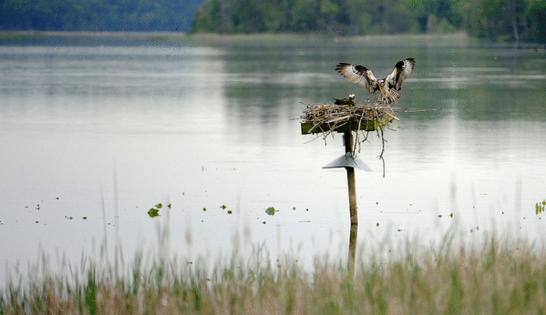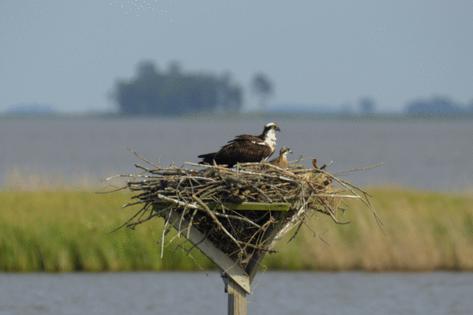Osprey starvation in the Chesapeake Bay spurs renewed debate about fish harvest
Published in Outdoors
BALTIMORE — The Owl Moon Raptor Center in Boyds in Montgomery County usually takes in about 50 ospreys a year for a mix of reasons, such as fishing line entanglements. But this year more than 80 of the birds were admitted, most of them young and battling starvation.
Many of the chicks and juvenile birds died shortly thereafter, said Suzanne Shoemaker, Owl Moon’s founder and executive director, having arrived at the center already emaciated. The organization, which relies on volunteers, had trouble keeping up with the intakes around their mid-August peak, she said. At one point, the center had six ospreys at once.
“It’s been difficult. We just do the best we can with what we’ve got, and keep trying to pump the fluids in, and get them eating quickly,” Shoemaker said. “We haven’t had a great percentage of ours make it, and it is depressing to see that.”
Scientists say what happened at Owl Moon is part of a larger story — a recent decline in the survival of newly hatched ospreys in the Chesapeake Bay region, which hosts the world’s greatest number of breeding pairs for the species, according to the U.S. Geological Survey.
The downturn has ignited concerns among environmental advocates that a small, silvery fish at the base of the bay food chain, called menhaden, is at the center of the osprey’s woes. New university research draws a connection as well.
But not everyone is convinced. And the company that harvests menhaden in the bay’s Virginia portion is pushing back against attempts to link its activities to the osprey decline — or to any weakening of the menhaden stock.
Until recently, the Chesapeake Bay’s osprey population was enjoying a tremendous rebound, following the federal ban of the pesticide DDT, which broke down into a chemical that thinned birds’ eggshells, causing increased chick mortality.
In the Chesapeake Bay, the osprey population skyrocketed between 1966 and 2022 — an estimated 1,800% increase — said David Ziolkowski, a USGS wildlife biologist, during an early August meeting of the Atlantic States Marine Fisheries Commission. But more recently, the data points to a declining population — not just in the bay, but in other states that host the birds, such as California, Florida and New Jersey.
In his August presentation, Ziolkowski listed the possible reasons, including low food availability, competition with other birds of prey such as eagles, and poor weather or water conditions. It’s also possible the osprey population in the bay has reached a level that no longer can be sustained, he said.
“Populations don’t grow forever,” he said. “At some point, dependency factors kick in, and resources — be that food or territories, nest platforms, et cetera — become limiting, and populations tend to level off.”
New research from Virginia’s College of William & Mary, led by professor Bryan Watts, indicates that food stress was the leading cause of low survival rates for young osprey this year in the Chesapeake. And osprey parents that relied on menhaden to feed their young suffered the most, Watts said.
Watts, with the help of the USGS, observed more than 500 osprey nests in 12 areas of the bay this year during breeding season from March to August. Data for one of the 12 areas, surveyed by USGS, has yet to be released, but nine of the remaining 11 areas did not meet a threshold required for maintaining the population — 1.15 young per set of parents.
All nine were all in places where ospreys are believed to rely heavily on menhaden, particularly for their nutritional value, Watts said.
“We have believed for quite a long time that menhaden are a keystone species for osprey,” said Watts, the director of William & Mary’s Center for Conservation Biology.
While osprey also consume other species, he said, “when you look at the lipid content — the energy content — of these fish, they’re not all the same.”
The two nest areas that did meet the target were both in tidal freshwater regions of the bay, where researchers believe ospreys consume gizzard shad and catfish instead.
The collective rate of reproduction, 0.55 young per pair, was an improvement compared with a smaller survey Watts conducted last year, which included 167 nest sites that yielded a troubling rate of 0.13 young per pair.
This year, by training cameras on many of the nests, and observing others by boat, Watts and his team could watch what unfolded.
Ospreys normally produce two to four eggs. If all goes well once those eggs hatch, the siblings are all fed equally, and grow at the same rate. But if food is scarce, a different trend plays out.
“If there’s not enough food that comes in, then what happens is that there’s a dominance hierarchy that forms within the brood, and the ‘Alpha chick’ will dominate the food,” Watts said.
While there were individual incidents of a mink and a raccoon invading nests and taking chicks, Watts said, overall a concerning trend emerged. A large portion of the nests in the poor study areas yielded only one surviving chick — 54.6% of them. In the two successful nest areas, the one-chick rate was 18.2%.
The recent findings have raised the volume of calls for tighter regulations on the commercial menhaden fishery, near the mouth of the Chesapeake Bay. One company, called Omega Protein, controls the harvest — authorized at 51,000 tons this year — and cooks the fish to create nutrient-rich fish oil.
The fishing boats use spotter planes to locate large schools of menhaden, and then capture them in large nets called purse seines, which can be more than 1,000 feet long, according to the National Oceanic and Atmospheric Administration. Other states, including Maryland, Delaware and New Jersey, have banned that netting practice for this fishery, according to NOAA.
In a statement to The Baltimore Sun, Ocean Harvesters, which operates the vessels that catch menhaden for Omega, pushed back against claims that its fishing could be harming the health of the menhaden stock.
“Despite the claims of special interest groups, it is important to note that there is currently no credible research that indicates a decline in the Atlantic menhaden population; neither on a coastwide basis nor migrating in and out of the Chesapeake Bay,” wrote Ben Landry, vice president of public affairs of Ocean Fleet Services, which owns Ocean Harvesters.
The Atlantic States Marine Fisheries Commission, the multistate compact that regulates the East Coast menhaden stock, lists the population as neither overfished nor experiencing overfishing. But advocacy groups, such as the Chesapeake Bay Foundation, say that analysis is too zoomed out, since it includes the entire Atlantic Coast — and there isn’t a stock assessment specific to the bay, as there is for rockfish or blue crabs.
Allison Colden, the Bay Foundation’s Maryland executive director, welcomed the inclusion of predator fish such as rockfish, which also rely on menhaden and are declining in the bay, in the ASMFC model. But she said the model is inherently limited because of its broad geographic scope.
“Because of the spatial resolution of the model, it still cannot resolve some of these very specific questions that we have about the Chesapeake Bay,” Colden said.
The Virginia fishery, which is regulated by the Virginia Marine Resources Commission, also has drawn concern from recreational anglers, a group of whom filed a lawsuit challenging the regulations in 2023. In its latest legal filing, the group called for the menhaden rules to be remanded back to the Virginia commission for further research on the fishery’s impact, said attorney David Reed of the Chesapeake Legal Alliance.
In a statement, the Virginia commission cited the latest “positive” Atlantic States stock assessment for menhaden as the backbone of its regulations.
“The stock assessment is presently a coastwide assessment but data from the Chesapeake Bay heavily influences the results given the size of the estuary and abundance of menhaden in the Bay,” wrote spokesman Zach Widgeon. “The stock is a single well mixed population with fish migrating in and out of the bay regularly during the season.”
At the August meeting of the Atlantic States Commission’s menhaden board — following the USGS presentation on ospreys — Maryland representatives proposed tighter regulations for the industrial menhaden fishery in the bay.
Lynn Waller Fegley, director of fishing and boating services for the Maryland Department of Natural Resources, proposed an addendum that would allow seasonal closures of the purse seine menhaden fishery “to ensure that animals such as osprey that depend on menhaden during critical points of their life cycle have the opportunity … to access these fish in Maryland.”
Her motion was backed by Russell Dize, a waterman serving on the commission’s menhaden board, with prior experience working on a menhaden, or “pogy,” boat.
He said watermen have struggled to harvest menhaden in the Maryland portions of the bay, and he believes the Virginia purse seine harvest is to blame. He initially planned to propose something more dramatic — a two-year moratorium on purse seine netting in the lower bay, he said.
“I want to save the creatures — the predators — that have two arms and two legs,” he said. “We can save the osprey, but I want to save our watermen, too.”
But other board members, including a representative from Virginia, voiced concern that the proposal singled out menhaden fleets without adequate research. As a result, Colden, who was serving on the board as a proxy, proposed a working group that would evaluate additional precautions for menhaden because of osprey. This measure passed, and the work group’s results are expected at the board’s next meeting in October.
In his statement, Ocean Harvesters’ Landry said fisheries managers “need additional research” to move forward, “not an irresponsible rush to judgment that could impact the livelihoods of generations of hard-working, union and largely minority watermen in the Chesapeake Bay.”
Citing the USGS research that did not isolate menhaden as the cause for osprey decline, Landry wrote: “Clearly there is an issue or issues much larger than menhaden harvest in the Bay. It is likely host of environmental reasons like climate change, competition from other piscivorous birds or other reasons for this wide-scale change.”
As fisheries managers debated new regulations, the wildlife rehabilitators at Owl Moon waged the uphill battle of saving the birds coming through their doors this year.
The center often rescued young ospreys in danger thanks to watchful neighbors, who notice concerning situations unfolding on the nesting platforms outside their waterfront homes, Shoemaker said — including nests with babies abandoned by their parents.
At the center, volunteers start by introducing oral fluids and subcutaneous fluids, Shoemaker said. Gradually, they add a liquid diet, including a powder version of the osprey diet. And then the staff members reintroduce small pieces of fish. Before that point, many of the young birds perished.
“They’re so starved that their digestive system has basically shut down,” Shoemaker said. “They’ve basically switched over to digesting their muscle. So that’s why they lose body condition fast.”
©2024 Baltimore Sun. Visit baltimoresun.com. Distributed by Tribune Content Agency, LLC.










Comments